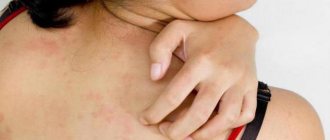Allergies are considered common. Various reasons can lead to the appearance of the disease. It often appears due to the use of certain medications. Iodine allergy is a common intolerance. It has its own symptoms that cannot be confused with other allergic reactions. How an allergy to iodine manifests itself and how to treat it is described in the article.
Causes
Iodine is a low molecular weight substance (halogen), which in itself is not considered an allergen. But after penetration into the body, it becomes a hapten, increasing its molecular weight due to its reaction with high-molecular proteins. The formation of conjugated immunoglobulins of class E occurs in the body, with which sensitization is triggered.
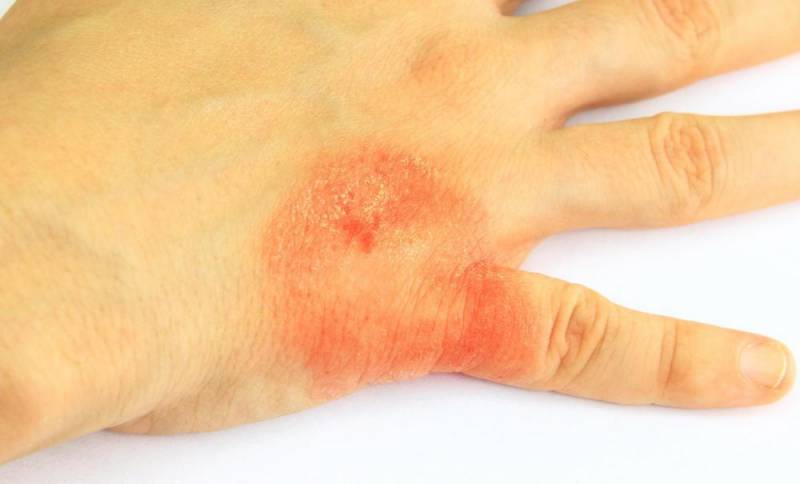
External signs usually do not appear upon first contact. Only when the allergen is re-entered does a release of active allergy mediators occur into the blood. It manifests itself on medications. This list consists of:
- potassium and sodium iodide;
- Lugol;
- alcohol solution of iodine;
- medications for the treatment of the thyroid gland;
- antiseptics;
- radiocontrast agents;
- drugs for arrhythmia.
The effect of iodine affects each person differently. The development of an unpleasant condition occurs in stages:
- The iodine-containing agent is converted into the form required for synthesis with high molecular weight proteins.
- Allergic immunoglobulins are formed.
- The immune system triggers reactions that provoke external manifestations of allergies.
Many medicines contain iodine. As indicated in the instructions for use, Iodomarin 200 mg is effective for iodine deficiency. In this case, you must be careful, as the product can cause allergies. As described in the instructions for use, “Iodomarin” 200 mg is not used for hyperthyroidism, toxic thyroid adenoma, Dühring’s dermatitis herpetiformis.
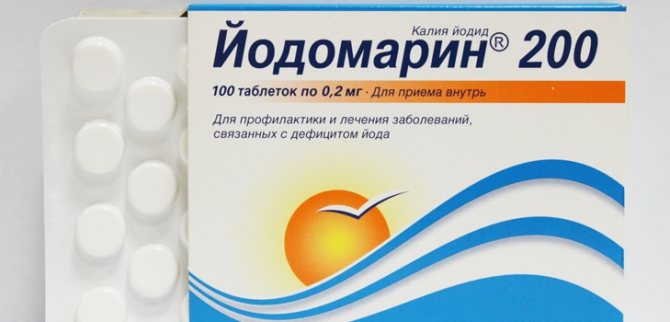
First aid
- Rinse the affected area under running water at room temperature for 15-30 minutes. If a burn from iodine on the face is detected immediately, then 15 minutes is enough. Do not use water that is too cold.
- Neutralize the effect of iodine with tooth powder, toothpaste, a solution of soap, chalk or sugar. The wound should be washed as quickly as possible; in the later stages the procedure will not produce results.
- Treat the affected area with ointments Bepanten, Panthenol, Olazol (can be purchased at the pharmacy). If the skin peels off, antiseptics are needed. Further treatment is possible if you consult a doctor. Antiseptic (wound disinfection), painkillers (pain relief), wound-healing (regenerating) drugs, and hygienic wound care are prescribed.
It is forbidden to neutralize eye damage yourself; this is done in medical institutions. The first aid that can be provided at home is only rinsing under running water.
When providing first aid it is prohibited:
- lubricate the affected areas with potassium permanganate or alcohol solutions;
- apply ice;
- pop blisters yourself.
Manifestation
How does an allergy to iodine manifest? Iododermatitis is detected after external use of products with iodine. It appears as:
These are skin symptoms of an allergy to iodine. But they can also be systemic. How does an allergy to iodine manifest itself? An allergic reaction is likely to include:
These are the main symptoms of how an allergy to iodine manifests itself. Severe manifestations of the disease include angioedema and anaphylactic shock. Allergies are usually mild or moderate in severity. A major health hazard arises from the intravenous administration of contrast agents. Such procedures should only be carried out by an experienced and competent specialist.

Degrees and features of localization
- First degree burns are characterized by redness and pain. There is partial damage to the epidermis - the upper layer of the skin.
- The second degree is characterized by the formation of blisters with liquid. Partial or complete damage to the epidermis occurs.
- Third degree A means complete damage to the epidermis, partial damage to the dermis layer. The blisters are filled with cloudy exudate. The victim loses pain sensitivity.
- Third degree B - the layer of subcutaneous fat is partially affected.
- The fourth degree is characterized by charring of tissues and complete loss of pain sensitivity. The condition is dangerous.
Lesions of stages 1 and 2 are superficial, stages 3 and 4 are deep. Burns with iodine solution are often superficial. People working in specialized chemical production receive deep damage.
Localization of damage - most often the limbs (arms, legs), eyes, face, and mucous membranes of the oral cavity are burned.
Yodism
A side effect of allergies is iodism, which has specific symptoms. The appearance of:
With iodism, there may be intestinal disorders and fever. Similar symptoms can occur with long-term use of iodine-containing drugs.
Allergy to potassium iodide during pregnancy
Thanks to iodine, thyroid hormones are formed in the thyroid gland. They have a great impact on the development of a child's brain. Therefore, if a pregnant woman has iodine deficiency, there is a great danger of both miscarriage and mental retardation of the fetus.
Iodomarin should not be taken in large doses. In case of an overdose of the drug, the following consequences may occur:
- Vomit.
- Diarrhea.
- Stomach ache.
- Unpleasant taste in the mouth.
If these signs appear, you should immediately stop taking the medication and consult a doctor.
In pregnant and lactating women, the need for such a microelement as iodine increases significantly, so it is important for them to use a sufficient amount of Iodomarin (200 mcg per day). The drug penetrates the placenta and is also excreted in breast milk. In this regard, the medicine should be used only in doses recommended by the doctor.
Diagnostics
Does a person have an allergy to iodine? How to check? To do this you need to pass a simple test. An alcohol solution of iodine is applied with a cotton swab to thin skin. If redness or a rash occurs in this area during the day, this confirms a predisposition to allergies. If there is no trace in the body, there is a lack of microelement.
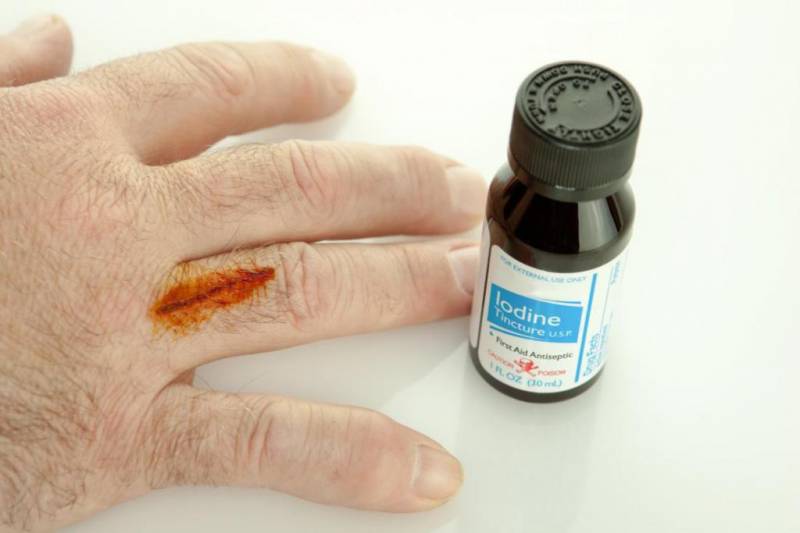
In the clinical setting, diagnostic testing should be performed prior to the planned administration of iodine-based radiocontrast agents. To do this, the required medication is administered in a small dose. If there are no pathological symptoms and you feel well, then the diagnosis can be continued. If symptoms of an allergic reaction are detected, they must be eliminated with antihistamines, and then a suitable contrast agent must be selected.
During diagnosis, age and the presence of chronic pathologies that may cause iodine allergy are of particular importance:
Skin tests are a meaningful diagnostic method. After such an event, the doctor can prescribe an effective treatment method.

Features and degrees of burn
The iodine burn
resembles a brown spot.
The size of the damage depends on the amount of product used and the area of application. In fair-skinned patients the burn is light brown, in dark-skinned patients the burn is dark. Over time, the burned cells begin to peel off. Based on the severity of damage, chemical burns are divided into 4 degrees:
- Light redness of the tissues in the 1st degree of damage does not cause significant discomfort; it may burn the skin a little due to its tightness.
- Grade 2 is characterized by the appearance of blisters with clear liquid that cause severe pain. The blisters cannot be burst, otherwise a scar or a source of secondary infection may form at this site. Sometimes in this condition the temperature may rise.
- Grades 3 and 4 are extremely rare and require urgent hospitalization. This usually includes iodine burns on the face
, eyes, and mucous membranes in the throat.
Therapy
How to treat an allergy to iodine? It is treated according to a similar principle as other forms of the disease. First, you need to limit the intake of the allergen into the body - iodine. The use of drugs containing this microelement must be discontinued. This is necessary to neutralize the accumulation of iodine in the body.
To relieve symptoms, the doctor prescribes drug therapy, which includes taking several medications:
- Antihistamines - “Loratadine”, “Telfasta”, “Cetrina”, “Erius”.
- For emergency care, 1st generation drugs are used - Diphenhydramine, Suprastin.
- Enterosorbents - “Polysorb”, “Smecty”, “Atoksila”.
You should not self-medicate. Any drug must be prescribed by a doctor. They are also prescribed the dosage and duration of treatment. Only by following these rules will it be possible to eliminate an allergy to iodine.
What to do
What to do if you get
before the doctor arrives is of interest to many patients. The first thing to know is that iodine injury is a chemical injury.
Next you need to act according to plan:

- The wound should be kept under running water for about 15 minutes.
- If there are no blisters or serious damage to the skin, then sprinkle the affected area with tooth powder. If you don’t have powder, you can dilute toothpaste with water and apply the product as an ointment. As a last resort, use a soap solution.
- Sweet water can also reduce the effects of the drug. To prepare a concentrated solution, you need to take 25 g of granulated sugar per 100 ml of liquid.
- Severe injuries cannot be treated at home. Before the doctor arrives, you can offer the patient pain medication.
For minor burns, the condition returns to normal within 2-3 days. If during this time there is no improvement or the patient has become worse or the temperature has risen, then consultation with a surgeon is required. Cloudiness of the fluid in the blisters is also an alarming sign and indicates infection.

If the mucous layers, eyes, or oral cavity are damaged, then nothing can be done, as this could lead to a deterioration in the patient’s well-being.
Treatment of iodism
If the disease occurs in the form of iodism, then a special treatment regimen is prescribed:
- It is necessary to exclude all iodine-containing products.
- Requires the use of antihistamines or injections.
- A course of 10 sessions of intravenous injections of calcium chloride is performed.
- Probiotics are taken to restore intestinal microflora - “Linex”, “Bifilife”.
A completed course of treatment prescribed by a doctor will eliminate the symptoms of an allergy to iodine. Therapy against iodism gives excellent results.

What not to do
If you receive a burn, the following is contraindicated:
- Apply ice.
- Apply oils.
- Warm up the burn site.
- Pop blisters.
- Apply alcohol solutions.
- Treat the outbreak with potassium permanganate.
If your eyes are damaged, no treatment should be used. In this case, only doctors can neutralize iodine. If your throat or tonsils are damaged, you can rinse your mouth with cool water.
About the features of first aid for a chemical burn in detail in this video
Elimination of skin symptoms
Skin manifestations are eliminated with anti-inflammatory, regenerating external agents:
- "Gistan".
- "Fenistil".
- "Solcoseryl".
- "Desitin."
With the development of anaphylactic shock, emergency qualified assistance is needed, intravenous administration of anti-shock drugs - Adrenaline, Dexamethasone. In case of severe bronchial spasm that impairs respiratory function, the surgeon performs a tracheotomy and inserts a special tube.
Diet
If you have iododermatitis, you should avoid eating food in which this component is present in large quantities. This substance is found in:
Iodine is present in shrimp, sea bass, mackerel, cod, and herring. It is advisable to consult a doctor about nutrition. It is necessary to find out the exact list of products acceptable for consumption.
ethnoscience
Such remedies are common among many people who prefer natural remedies rather than pharmaceutical medications. There are recipes to eliminate itching that appears from medications containing iodine.
Coconut oil is the best remedy to relieve itchy skin. It is enough to apply it in a small amount to painful areas. Vaseline is also used, which not only eliminates itching, but also reduces skin irritation - you just need to apply a thin layer of it to the site of the rash.
Itching is relieved with baking soda. To do this, you need to prepare a paste: dilute 3 parts baking soda with 1 part water. The paste is applied to the itchy area. But you should not use the product on damaged or scratched skin. Traditional medicine is considered effective and safe.
How to treat at home
Traditional methods will help relieve severe pain, restore skin and speed up wound healing:
- means for neutralizing iodine burn: 2 tbsp. dissolve sugar in 80 ml. water, stir until completely dissolved;
- A bandage using potato pulp or pumpkin pulp will help treat a burn from iodine;
- a painful symptom can be relieved by applying a bandage soaked in black tea;
- Cook the oatmeal in water as usual. Apply warm porridge to the wound and secure with a bandage;
- apply lotions with sea buckthorn oil;
- lubricate the affected area with aloe juice:
- prepare a decoction of oak or ivy bark (pour 1 tablespoon of raw material into 200 ml of boiling water);
- You can remove irritation with ointment: 4 tbsp. Boil burdock root in 1 liter. boiling water boil until the volume of the solution is reduced by half. Next, divide the liquid in half, add butter;
- prepare an ointment from beeswax, vegetable oil (component ratio 3:1);
- Beat chicken protein with a mixer until foam forms. Apply directly to the wound;
- hard boil 2 eggs. Separate the yolk from the white and place it in a frying pan. Heat over low heat until liquid begins to release. This liquid should be lubricated on the affected areas to remove irritation;
- applying toothpaste will help get rid of the wound and remove pain;
- The burn will go away faster if you use bandages with honey.
A contraindication for the use of home remedies is individual sensitivity to the composition of the listed recipes. If allergic reactions occur, stop treatment.
Iodine replacement
If you are allergic to iodine, what can you replace it with? Zelenka is suitable for treating wounds. It is advisable to consult a specialist about a suitable drug. Iodine analogues include:
- Fine-crystalline iodine, instant soluble.
- "Iodinol."
- Alcohol "Iodine".
Instructions are included with each drug. It is necessary to read it before using any product. The active ingredients, indications and contraindications are indicated there. Following the instructions will prevent side effects from occurring.
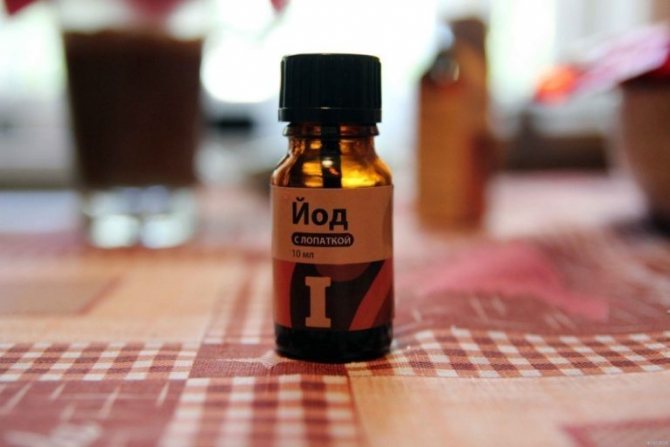
How to give first aid
It is possible to remove traces of burns from iodine at home; to do this, you need to carry out the following manipulations:
- Place the affected area of the body under warm water. Keep under water for 10 minutes. If 20 minutes or more have passed since the burn, it will take 30 minutes to restore the skin with warm water.
- Next, mix the soap solution, 20% sugar solution and chalk; the last ingredient can be replaced with tooth powder.
- Try sea buckthorn oil, it perfectly heals open wounds and penetrates deep into the skin. The compress is applied over the next three days; you can treat the skin with a cotton swab dipped in oil.
- If the burn is severe and painful, boil oatmeal porridge until it has a slimy consistency. Set aside the container of porridge until it cools. Apply the mask for 20-30 minutes, then rinse gently. Hercules is an excellent anti-inflammatory agent with a healing effect.
- If the pain prevents you from sleeping and there is no way to get to the hospital, use the following recipe. Beat a raw egg and spread it on your body, you can replace it with tooth powder, they are similar in effect. Repeat the procedure every day 3-4 times.
- Apply a bandage with Rescuer ointment to the damaged area.
Medicines that help restore the skin after a burn from iodine are included in the following list:
- antiseptic - help to avoid infection in the wound;
- painkillers – relieve pain shock;
- wound healing – promote rapid restoration of the epidermis;
- eliminating tissue swelling - in addition to direct action, they prepare the surface for subsequent therapy.
You can buy a lot of effective remedies against iodine burns at the pharmacy, but first it is better to consult a doctor. Panthenol, Olazol, Furaplast are in great demand. However, the latter medicine is not allowed to be applied to purulent wounds, because the specificity of its action is such that the medicine forms a dense wound-healing film that prevents the pus from coming out.
What else should you pay attention to? Set aside antithermal drugs; in case of a chemical burn, they only aggravate the deplorable situation and delay time that could be spent on proper treatment of the disease.
Give preference to the following wound healing ointments:
- Bepanten - in addition to the main active ingredient, it contains vitamins. The medicine accelerates metabolism inside the cell and normalizes microcirculation, the epithelium is restored faster than usual.
- Chlorhexidine is a colorless liquid substance with good antiseptic characteristics. A cotton swab is moistened with the composition and applied to the skin for five minutes. Compresses are effective if you repeat them at least 3 times a day.
Prevention
Once an allergy occurs, it will be difficult and sometimes impossible to get rid of it. But it will be possible to minimize the exacerbation of the disease if you avoid contact with allergens. Prevention measures include:
Diagnostics with the introduction of contrast liquid with iodine is not carried out if:
The manifestation of an allergy to iodine can be corrected by eliminating medications and products with this component. In some cases you can replace it. In any case, the manifestation of symptoms of the disease is a reason to contact a specialist. He will advise you on ways to correct your lifestyle and select the best treatment option. Thanks to effective therapy, iodine allergies can be eliminated.
Consequences
Typically, an iodine solution does not cause serious damage. Redness, allergic manifestations, and a dark spot may persist at the burn site. Recovery is more difficult in patients with damage to the mucous membranes and eyes.
The greatest danger comes from oral consumption of the pure product. In this case, the lethal dose is about 3 g of the substance.
Even if a smaller amount of medicine is drunk, patients experience serious disturbances in the functioning of the kidneys, digestive, respiratory, and cardiovascular systems.
Iodine burns occur quite often in everyday life. Usually it does not cause significant harm to health. To prevent negative consequences when using the product, you should carefully follow the recommendations specified in the annotation.
Many hospitals have long abandoned the use of iodine, but at home they are accustomed to resorting to this remedy in case of injuries and minor wounds.
But often it is used incorrectly, the concentration is too high, and the result is a burn to the skin that was treated with iodine
.
This thing is unpleasant, painful and can leave a mark in the form of a brown crust for a long time. What to do in case of an iodine burn and how to treat it?
